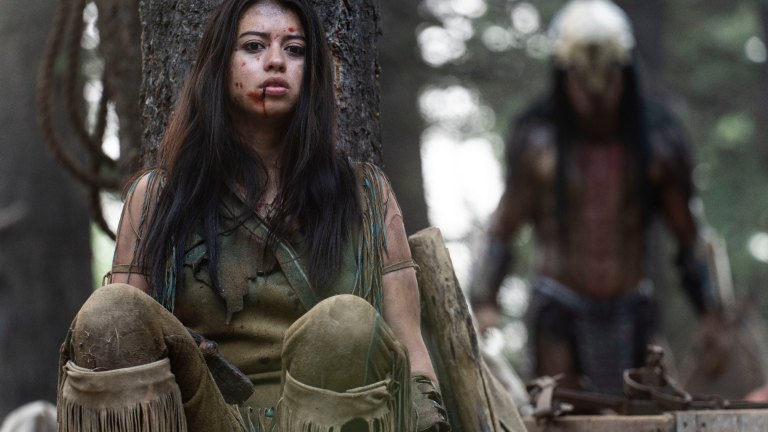Prey Review: Predator Franchise Finally Hits Its Stride
The Predator series goes back in time and back to its roots for an old-fashioned monster hunt in the gripping Prey.

Prey is the fifth installment in the Predator franchise (and seventh if you count the two Alien vs. Predator films). It’s also easily the third best in the series by default, following the original Predator and 2010’s underrated Predators. The bar is, admittedly, fairly low for this series, which is marked by pretty unwatchable entries like Shane Black’s 2018 The Predator and 1990’s Predator 2 (although some Den of Geek staff keep threatening to write a re-appreciation of the latter). Nevertheless, we’re pleased to say that Prey takes an approach that is both fresh and back to basics with this material, making a solid, suspenseful thriller while scaling back any ambitions that have sunk past films.
For one thing, Prey takes the franchise back to nature, in this case a forest and plains, which is where it belongs. The best Predator films work in such an environment, whether it’s a jungle or woodlands, while the crappier ones are set in urban or suburban environments.
There’s just something that doesn’t work when the Predator can land in a high-visibility setting—one starts to wonder why there isn’t a full-on military response? Even if the government is typically trying to keep the existence of the creatures a secret, it seems as if they would have to step in when carnage reigns over a major metropolitan area.
In this case, however, we’re not only in a forest, but we’re on the Northern Great Plains some 300 years ago, with the movie focusing on a Comanche tribe that comes under attack from a Predator who lands on the planet. The protagonist is a young woman named Naru (Amber Midthunder), a highly proficient tracker and hunter who is nevertheless dismissed by the male members of her tribe, including her own brother (Dakota Beavers), especially when she warns that the threat they face is much more dangerous than a lion or other wild animal.
By setting the film in the 17th century and placing the Predator in conflict with a Native American tribe and a female warrior, the movie immediately creates a greater sense of tension: How can this relatively arcane civilization—when compared to the creature itself and modern day militaries—defend itself against a thing that must seem like a god? Can arrows and spears work against an invisibility cloak and plasma weapons?
The setup and plot, largely devoid of the attempts at background mythology that has bogged down other entries, is simplicity itself, as Naru, her brother, and several other warriors head into the forest to find what’s stalking their village and kill it, only to get much more than they bargained for.
As Naru, Midthunder (recently seen on Roswell, New Mexico and opposite Liam Neeson in The Ice Road) has an appealing, no-nonsense believable presence, even if her range is somewhat limited. The rest of the cast, comprised almost entirely of Native American and First Nation actors, is similarly physically impressive even if their characters are barely sketched in.
The biggest mistake the movie makes, however, is the way in which it handles dialogue. While the film is in English with a few Comanche words here and there, the young actors make no attempt at all to sound like humans from an earlier era; much of the dialogue is delivered as if they’re twentysomethings living in 2022 who are doing some cosplay in the woods.
It’s jarring, especially when set against their visual accuracy and detail, and takes one out of the movie (there is an all-Comanche version available, which might work better, but we’ve not had a chance to sample it).
That aside, the cast is convincing in the action scenes, and director Dan Trachtenberg (10 Cloverfield Lane) keeps the narrative moving at a brisk clip. As for the Predator itself (played this time by former pro basketball player Dane DiLiegro), it’s essentially a modest variation on the classic template. We have a slightly different look and array of weapons, but it’s still recognizably the Predator. Also the effects, a mix of DiLiegro in the suit and CGI, are actually handled quite well.
Trachtenberg also takes advantage of the vast, beautiful landscapes of the Stoney Nakoda Nation near Calgary, where much of the film was shot, adding to the authentic period feel and creating an oppressive aura of dread as Naru and company venture deeper into the overbearing forest.
There’s been some grumbling among fans about the fact that 20th Century Studios (a subsidiary of Disney) has chosen to premiere this film on Hulu rather than as a theatrical release like every previous Predator movie. But a quick look at the box office history shows that the series has never been more than a modest box office success overall, and the last entry, The Predator, was an expensive flop.
Combine that with still-lingering COVID effects on the box office, a film with zero name stars in it, and also a film that doesn’t skimp on gore and would probably receive an R rating, and it makes perfect sense for Disney to take the much less risky route of streaming the film on one of its two major platforms where it probably has a far better chance of being seen.
The truth is it somehow feels okay to do this. Prey is a modest sci-fi action thriller, a return as we said in many ways to the series’ simple roots, and largely successful on its own terms as a result. The Predator series has tried in the past to compete with the much more expansive Alien franchise, and we now know it’s better off not trying. This is a monster movie, a hunter-vs-hunted narrative with a sci-fi twist, and in the end, that’s all you really need. But make sure you stay tuned through the end credits.
Prey is now streaming on Hulu.
